
A flat, well-toned abdomen is something many of us strive for through diet and exercise. However, sometimes these efforts don’t achieve our desired results. Factors like pregnancy, aging, significant weight fluctuations, heredity, and prior surgeries can leave us with excess fat and loose, sagging skin that resists lifestyle changes. If you’re struggling with these issues, a tummy tuck (abdominoplasty) might be the solution you’re looking for.
What is a Tummy Tuck?
A tummy tuck, or abdominoplasty, is a surgical procedure that removes excess skin and fat from the abdomen while tightening weakened or separated abdominal muscles. The result is a smoother, firmer abdominal profile that better reflects your body contouring goals.
This procedure is particularly effective for:
- Eliminating excess abdominal skin and fat
- Tightening weakened abdominal muscles
- Restoring a firmer, flatter stomach area
- Improving posture and reducing back pain in some cases
- Enhancing body contour after significant weight loss or pregnancy
Types of Tummy Tuck Procedures
Depending on your specific needs and desired outcomes, there are several types of tummy tuck procedures available:
Full (Traditional) Tummy Tuck
Best for patients with significant excess skin and fat both above and below the navel, as well as weakened abdominal muscles.
What it involves:
- A horizontal incision between the hip bones, typically along the bikini line
- A second incision around the navel
- Removal of excess skin and fat
- Tightening of abdominal muscles
- Repositioning of the navel
Recovery time: 4-6 weeks before returning to normal activities
Mini Tummy Tuck
Ideal for patients with less excess skin concentrated below the navel, good skin elasticity, and minimal muscle weakness.
What it involves:
- A shorter horizontal incision along the lower abdomen
- Removal of excess skin and fat below the navel
- Possibly some muscle tightening
- No navel repositioning
Recovery time: 2-4 weeks before returning to normal activities
Extended Tummy Tuck
Recommended for patients with excess skin and fat extending to the flanks and lower back.
What it involves:
- A longer horizontal incision that extends beyond the hip bones
- Removal of excess skin and fat from the abdomen, flanks, and lower back
- Tightening of abdominal muscles
- Navel repositioning
Recovery time: 4-6 weeks before returning to normal activities
360° Tummy Tuck
Combines traditional abdominoplasty with circumferential body contouring, addressing the abdomen, flanks, and lower back in one procedure.
What it involves:
- A circumferential incision around the torso
- Removal of excess skin and fat from the entire midsection
- Tightening of abdominal muscles
- Repositioning of the navel
Recovery time: 6-8 weeks before returning to normal activities
Before And After Photos Of Tummy Tuck Surgery
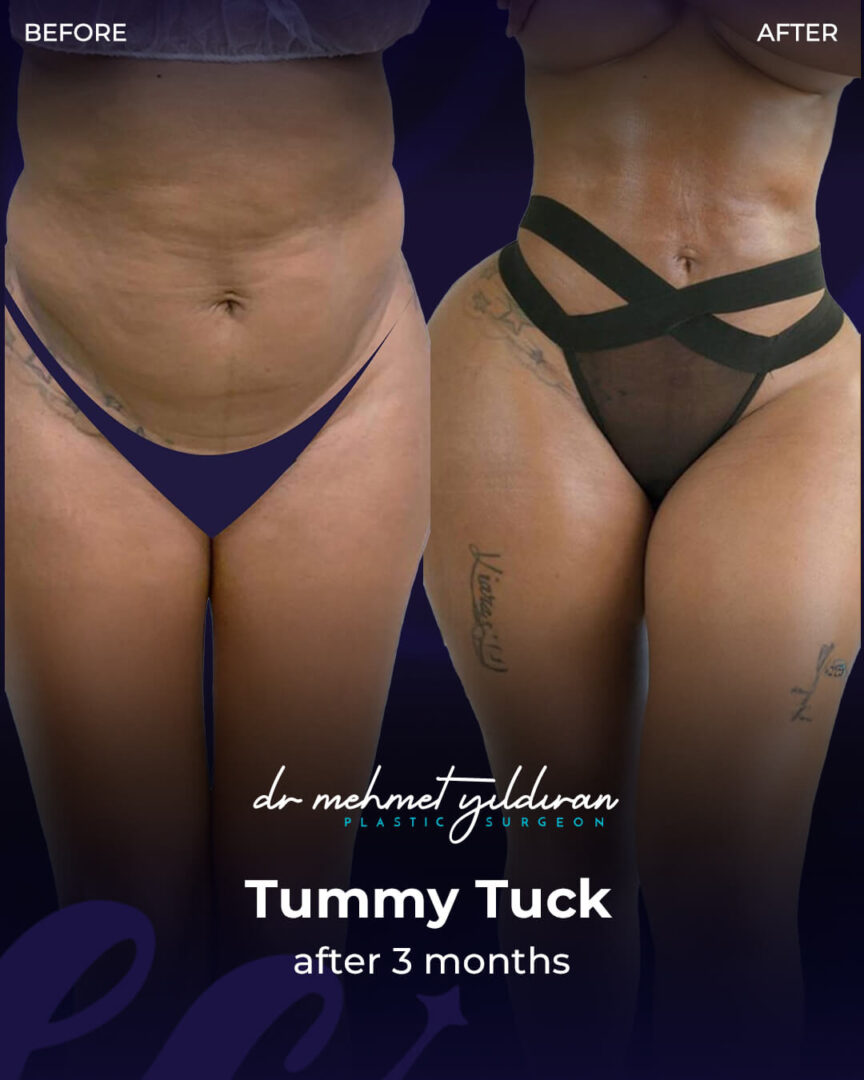
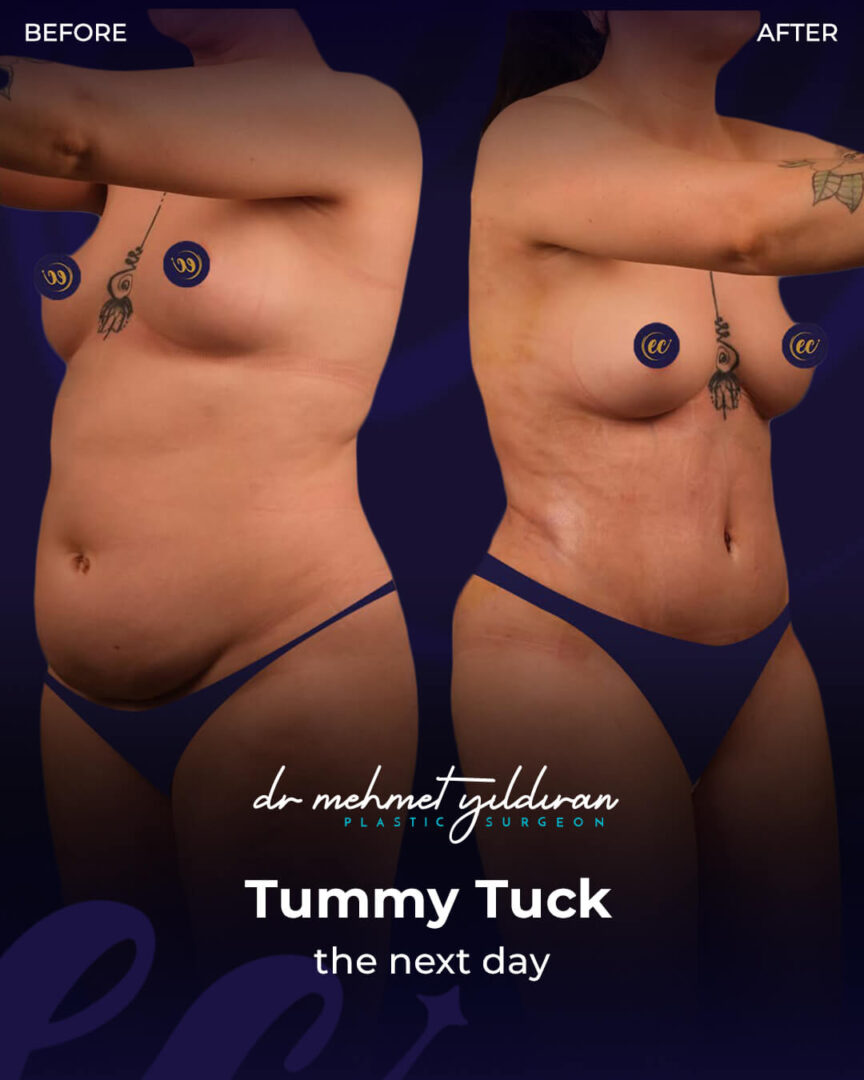
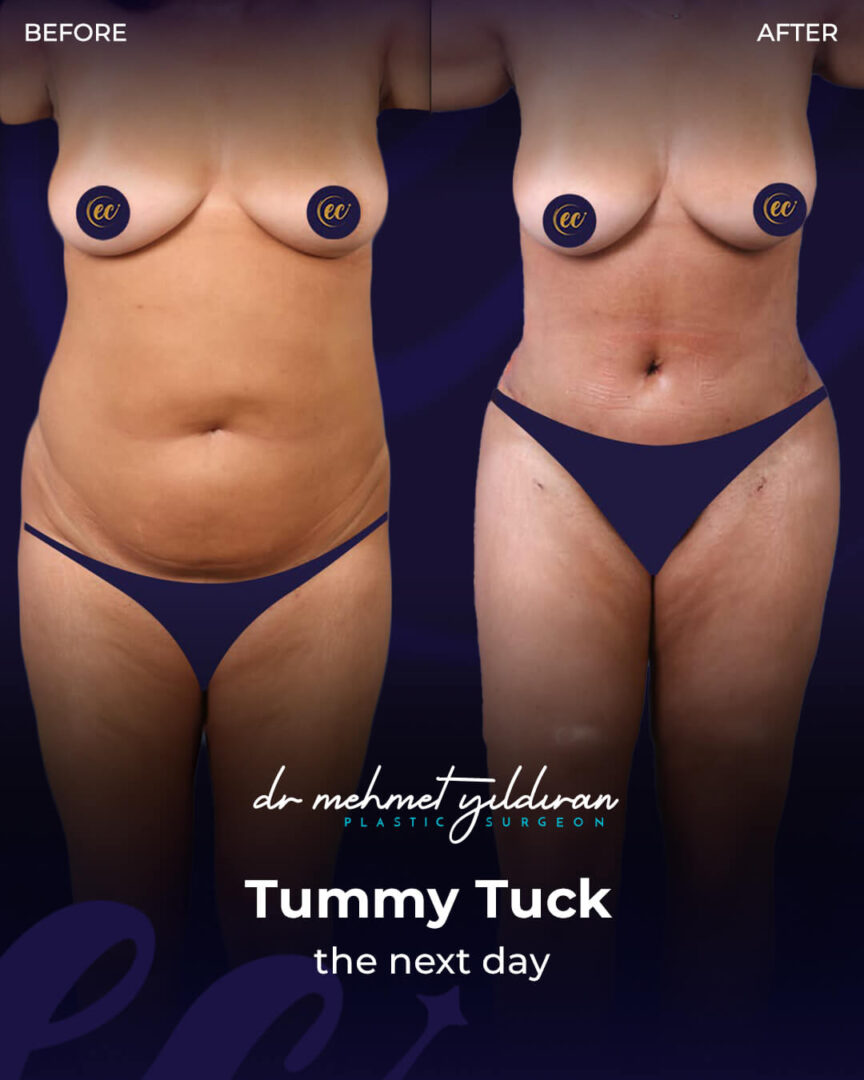


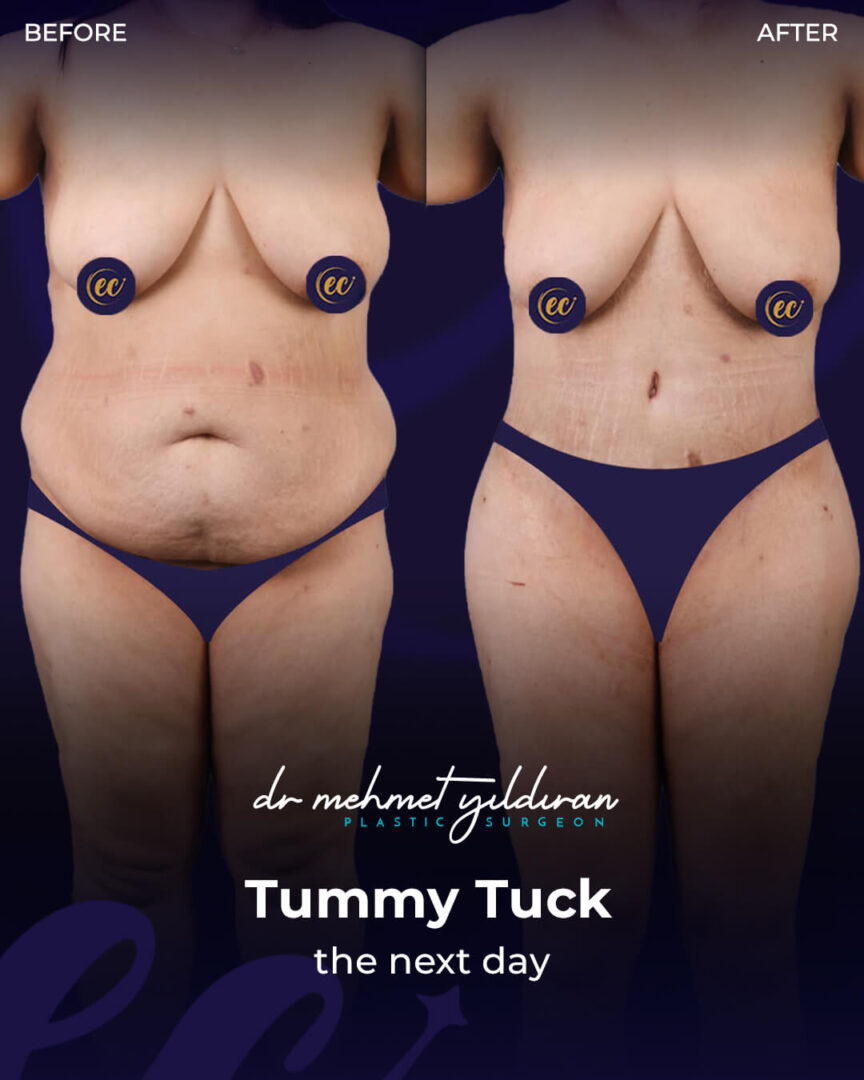
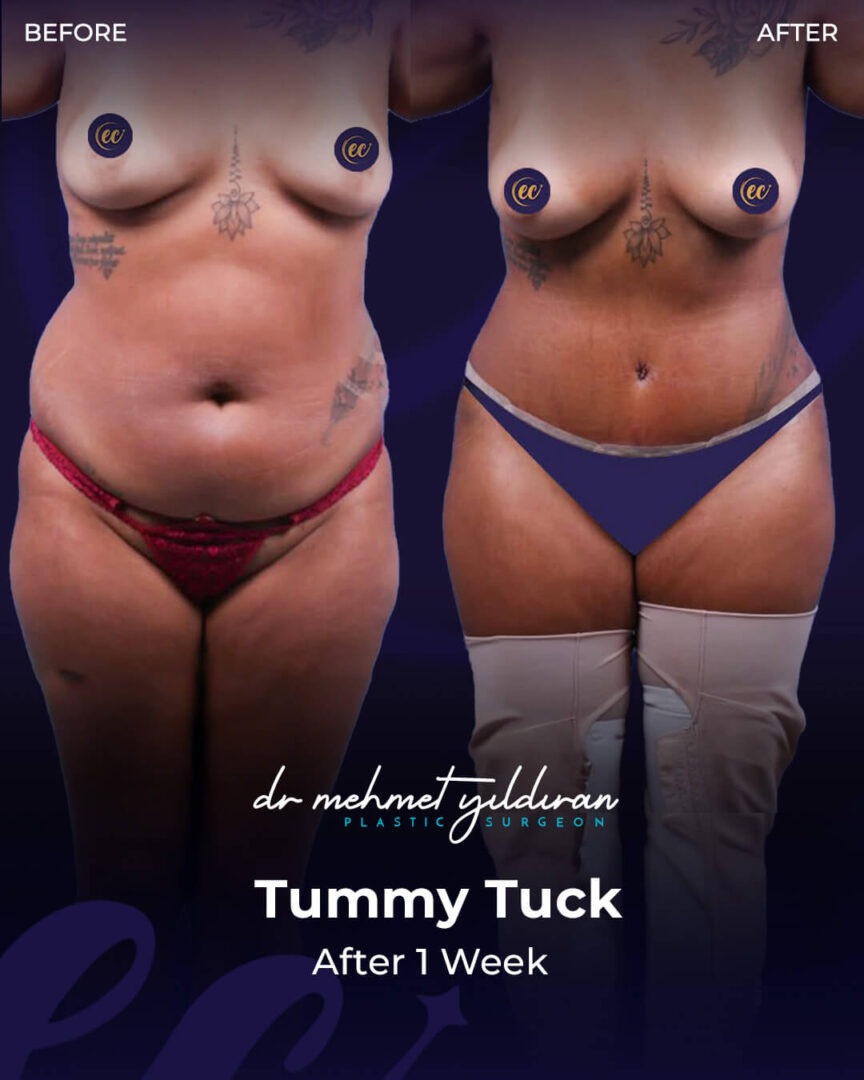
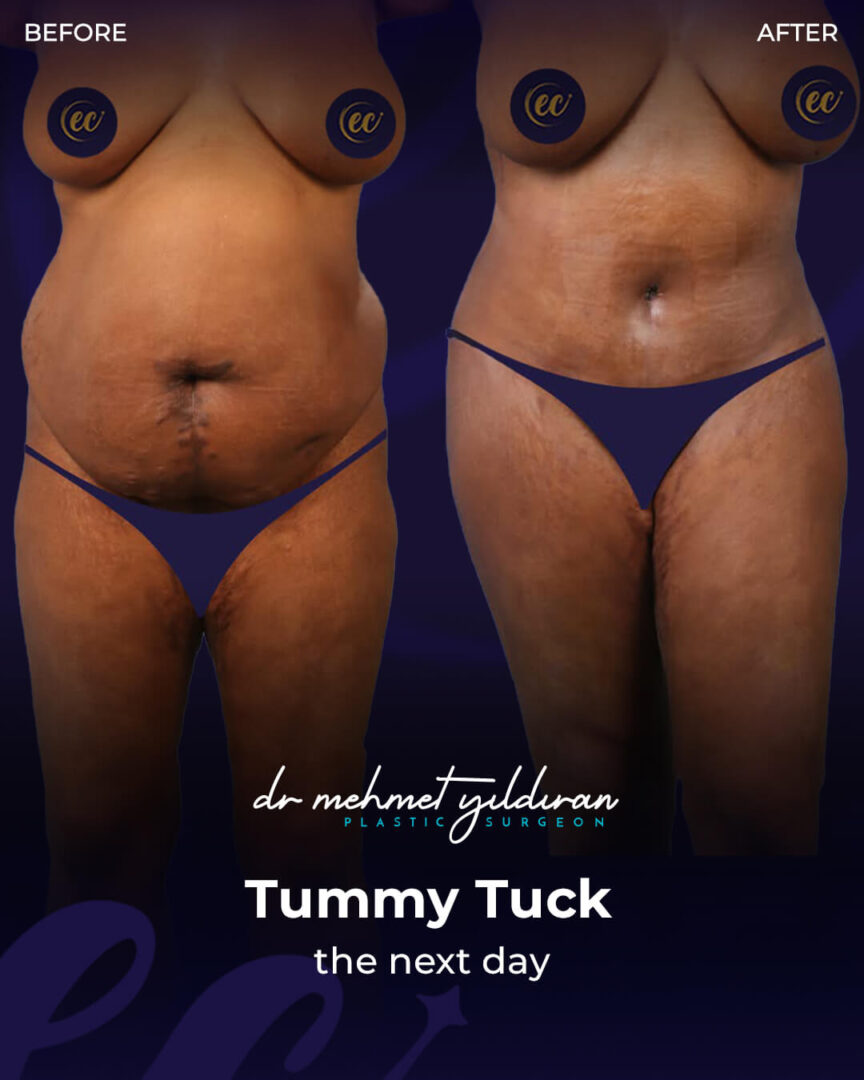
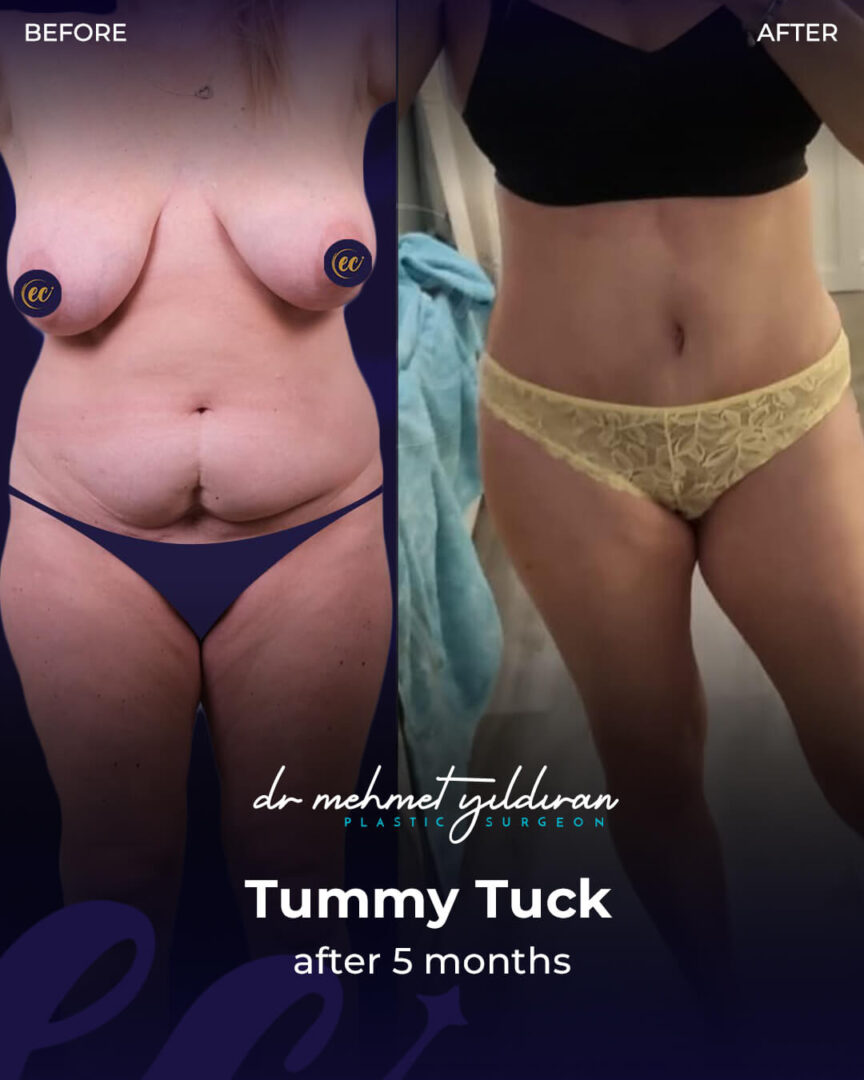
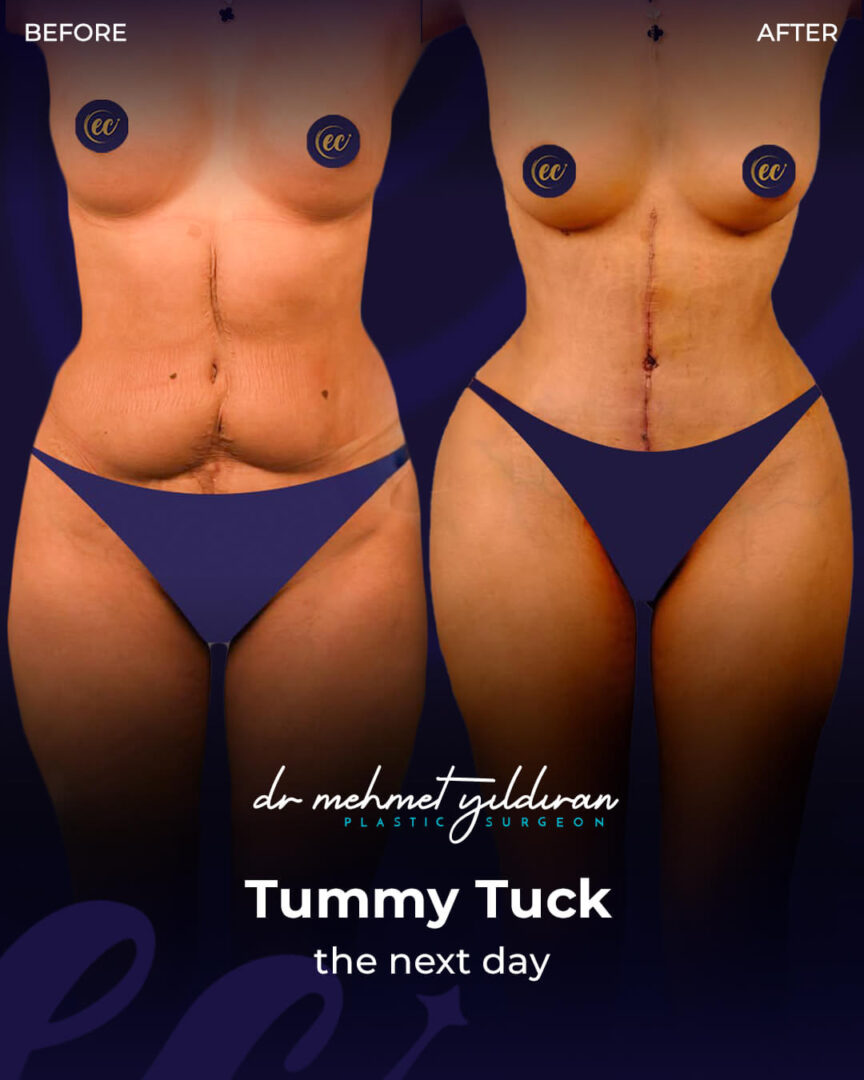
Who is an Ideal Candidate?
Good candidates for a tummy tuck include:
- Individuals at a stable weight, preferably within 10-15% of their ideal weight
- People with excess abdominal skin and fat that doesn’t respond to diet and exercise
- Women who have completed their pregnancies and are not planning more children
- Non-smokers or those willing to quit well before surgery
- People with realistic expectations about results
- Individuals in good overall health without serious medical conditions
It’s important to note that a tummy tuck is not a weight-loss procedure. It’s designed to contour the body after you’ve already reached a healthy weight.
The Tummy Tuck Procedure: What to Expect
Before Surgery
- Consultation: Your surgeon will evaluate your health, discuss your goals, and recommend the most appropriate procedure.
- Preparation: You may need to:
- Undergo medical evaluations or lab tests
- Stop smoking at least six weeks before surgery
- Avoid certain medications that increase bleeding risk
- Arrange for help during your recovery period
During Surgery
- Anesthesia: General anesthesia is typically administered for comfort during the procedure.
- Incisions: The surgeon makes incisions based on the type of tummy tuck you’re having.
- Tissue Removal and Muscle Repair: Excess skin and fat are removed, and weakened abdominal muscles are repaired and sutured together if needed.
- Skin Closure: The remaining skin is pulled down and sutured in place, and a new opening is created for the navel if necessary.
- Drain Placement: Small tubes may be placed to drain excess fluid during healing.
- Wound Closure: Incisions are closed with sutures, skin adhesives, or surgical tape.
The entire procedure typically takes 2-4 hours, depending on the extent of the surgery.
After Surgery
- Recovery Room: You’ll spend time in a recovery area for monitoring before being discharged or moved to a hospital room.
- Dressings and Drains: Surgical dressings will cover your incisions, and you may have drainage tubes in place.
- Compression Garment: You’ll need to wear a special compression garment to minimize swelling and support your abdomen.
Recovery Timeline
First Week
- Rest with your upper body slightly elevated and your knees bent
- Manage pain with prescribed medications
- Empty and record drainage from tubes (if present)
- Walk slightly bent at the waist to avoid tension on incisions
- Avoid strenuous activities and lifting
1-2 Weeks
- Drainage tubes typically removed
- Continued use of compression garment
- Gradual return to light activities
- Stitches may be removed (if not dissolvable)
- Begin to stand more upright
2-4 Weeks
- Return to desk work (if approved by your surgeon)
- Continued use of compression garment
- Increased light activity
- Most swelling and bruising begins to subside
4-6 Weeks
- Possibly return to more physical work (with surgeon’s approval)
- Begin light exercise (if approved)
- Possibly discontinue compression garment
6 Weeks and Beyond
- Gradual return to normal activities and exercise
- Final results begin to appear as swelling continues to decrease
- Scars begin to mature and fade (this process continues for 12-18 months)
Potential Risks and Complications
Like any major surgery, a tummy tuck carries risks, including:
- Anesthesia risks
- Bleeding and hematoma
- Infection
- Poor wound healing or skin loss
- Fluid accumulation (seroma)
- Changes in skin sensation
- Skin discoloration or prolonged swelling
- Asymmetry or contour irregularities
- Persistent pain
- Deep vein thrombosis, cardiac and pulmonary complications
- Possibility of revision surgery
Choosing a board-certified plastic surgeon and following all pre- and post-operative instructions can help minimize these risks.
Combining Tummy Tuck with Other Procedures
Many patients choose to combine their tummy tuck with other body contouring procedures for more comprehensive results:
Liposuction
Removes stubborn fat deposits from areas like the flanks, back, or thighs that aren’t addressed by the tummy tuck alone.
Breast Surgery
Breast augmentation, lift, or reduction can be performed simultaneously, often as part of a “Mommy Makeover” for women after pregnancy.
Lower Body Lift
Addresses sagging skin on the buttocks, outer thighs, and hip region in addition to the abdomen.
Arm or Thigh Lift
Removes excess skin from the arms or thighs for patients who have experienced significant weight loss.
Combined procedures can offer the advantage of a single recovery period but may increase surgery time and potential risks.
Tummy Tuck Costs in 2025
The cost of a tummy tuck varies significantly based on:
- Geographic location
- Surgeon’s experience and reputation
- Type of procedure
- Facility fees
- Anesthesia fees
- Post-surgery garments
- Medications and follow-up care
Average Cost Comparison
| Location | Price Range (USD) |
|---|---|
| United States | $6,000 – $15,000 |
| United Kingdom | $5,000 – $10,000 (£4,000 – £8,000) |
| Turkey | $2,500 – $5,000 |
| Europe (average) | $4,000 – $12,000 (€3,500 – €10,000) |
What’s Typically Included
- Surgeon’s fee
- Anesthesia
- Operating room facilities
- Pre-operative tests
- Post-surgery garments
- Follow-up appointments
What May Not Be Included
- Prescribed medications
- Additional post-operative care
- Treatment for complications
- Revision surgeries if needed
Medical Tourism for Tummy Tuck
Turkey has emerged as a leading destination for tummy tuck procedures, attracting thousands of international patients annually. Here’s why:
Advantages of Getting a Tummy Tuck in Turkey
Cost Savings: Prices are typically 60-80% lower than in the US or UK, with similar quality standards.
Experienced Surgeons: Many Turkish plastic surgeons are internationally trained and board-certified, with extensive experience in abdominoplasty.
Modern Facilities: Private clinics and hospitals in Turkey, particularly in Istanbul, feature state-of-the-art technology and adhere to international healthcare standards.
Comprehensive Packages: Most Turkish clinics offer all-inclusive packages covering:
- Surgery and hospital stay
- Accommodation (usually 7-10 nights)
- Airport transfers
- Interpreter services
- Post-operative care
Vacation Opportunity: Combine your procedure with exploring Turkey’s rich cultural heritage, beautiful landscapes, and historical sites.
Considerations for Medical Tourism
Research: Thoroughly investigate the credentials of your chosen surgeon and facility.
Communication: Ensure your surgeon speaks your language or that translation services are available.
Travel Time: Plan for adequate recovery before your return flight (typically 7-10 days minimum).
Follow-up Care: Discuss how post-operative complications will be handled once you return home.
Insurance: Most travel insurance policies do not cover elective procedures, so consider specialized medical tourism insurance.
Long-Term Results and Maintenance
A tummy tuck provides long-lasting results, but maintaining them requires:
Weight Management: Significant weight fluctuations can stretch the skin again and compromise your results.
Healthy Lifestyle: Regular exercise and a balanced diet help maintain muscle tone and prevent fat accumulation.
Pregnancy Considerations: Future pregnancies can separate muscles again and stretch the skin, potentially reversing the benefits of surgery.
Scar Care: Proper scar management, including silicone sheets, creams, and sun protection, helps minimize the appearance of scars over time.
Choosing the Right Surgeon
The success of your tummy tuck largely depends on your choice of surgeon. Consider these factors:
Board Certification: Verify that your surgeon is certified by the appropriate plastic surgery board in their country.
Specialization: Look for a surgeon who regularly performs tummy tucks and has extensive experience with your specific type of procedure.
Before and After Gallery: Review their portfolio to ensure their aesthetic approach aligns with your goals.
Patient Reviews: Research testimonials and reviews from former patients.
Comfort Level: Choose a surgeon with whom you feel comfortable discussing your concerns and goals.
Facility Accreditation: Ensure the surgery will be performed in an accredited surgical facility.
Conclusion
A tummy tuck can be a transformative procedure that helps you achieve the flatter, firmer abdomen that diet and exercise alone couldn’t deliver. With advances in surgical techniques, improved safety protocols, and more affordable options through medical tourism, 2025 offers excellent opportunities for those considering this body contouring procedure.
However, it’s crucial to approach this decision with realistic expectations, thorough research, and a commitment to maintaining your results through lifestyle choices. By choosing a qualified surgeon and following all pre- and post-operative guidelines, you can maximize your chances of a successful outcome that enhances both your appearance and self-confidence.
Remember that while a tummy tuck can dramatically improve your abdominal contour, the best results come from viewing it as part of a comprehensive approach to wellness that includes healthy eating, regular exercise, and positive body image.


